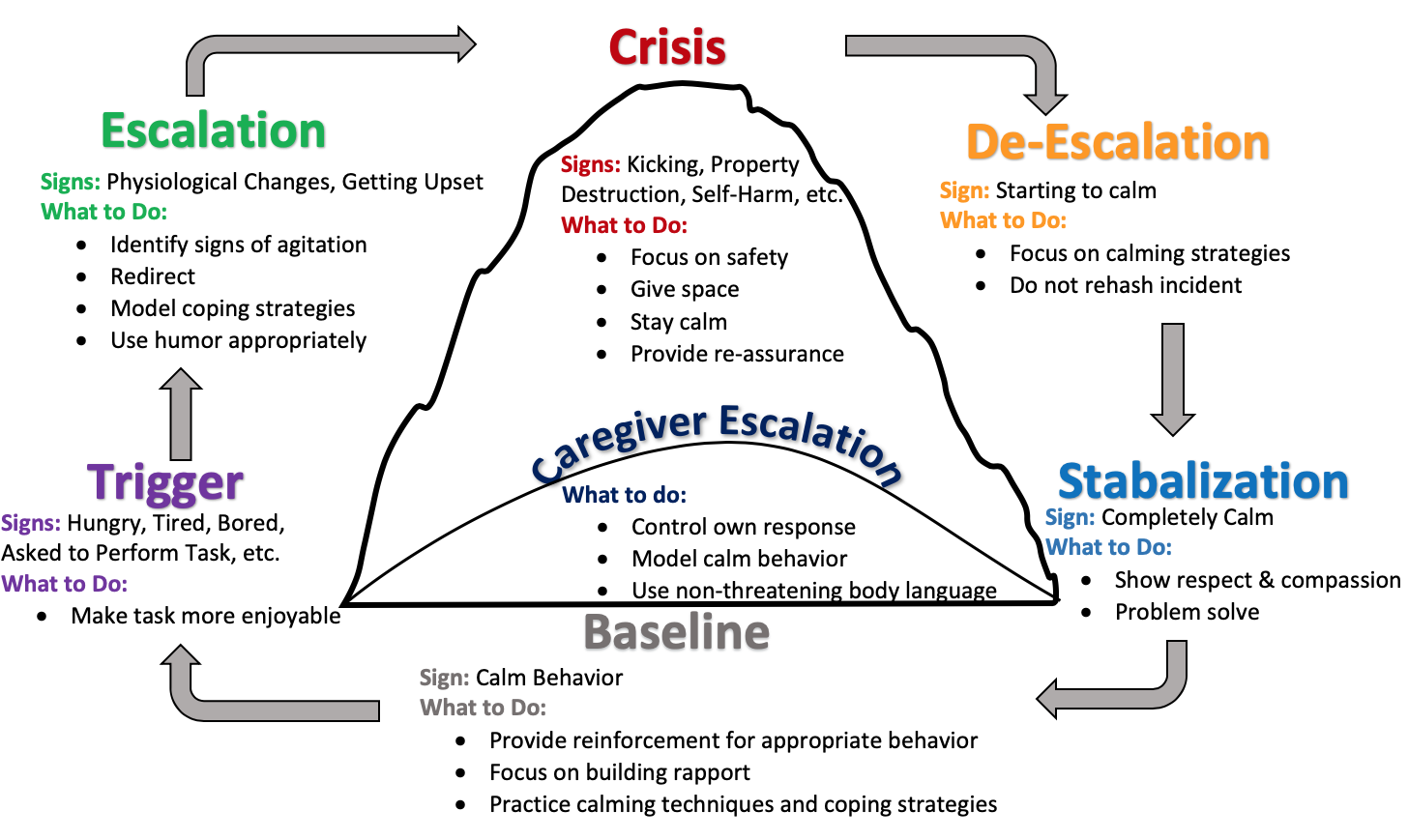
Winter 2020
Download a copy of the Winter 2020 Support Report (PDF)
Calming the crisis: defusing challenging behavior
Challenging behavior is often the expression of an unmet need, and in many instances that need is for control, empathy or an environmental change (Tanwar, Lloyd, & Julies, 2016). Recognizing the signals of an individual escalating allows for intervention before the situation reaches a crisis point. Intervening early can potentially keep the situation from escalating to the individual exhibiting challenging behaviors.
The escalation cycle:
This graphic depicts the stages of the escalation cycle of behavior. Understanding the signs and knowing what to do at each stage allows both the individual and the caregiver the opportunity to more effectively manage the situation.

-
1. Baseline
Signs: Calm Behavior
What to Do:
- Provide reinforcement for appropriate behavior
- Focus on building rapport
- Practice calming techniques and coping strategies
-
2. Trigger
Signs: Hungry, Tired, Bored, Asked to Perform Task, etc.
What to Do:
- Make task more enjoyable
-
3. Escalation
Signs: Physiological Changes, Getting Upset
What to Do:
- Identify signs of agitation
- Redirect
- Model coping strategies
- Use humor appropriately
-
4. Crisis
Signs: Kicking, Property Destruction, Self-Harm, etc.
What to Do:
- Focus on safety
- Give space
- Stay calm
- Provide re-assurance
Caregiver Escalation
What to Do:
- Control own response
- Model calm behavior
- Use non-threatening body language
-
5. De-Escalation
Sign: Starting to calm
What to Do:
- Focus on calming strategies
- Do not rehash incident
-
6. Stabilization
Sign: Completely Calm
What to Do:
- Show respect & compassion
- Problem solve
How to intervene:
- Establish and maintain a good rapport
- Build relationships based on dignity and respect
- Avoid power struggles by providing choices and options
- Listen to gain trust and respect the individual’s decisions
- Be aware of potential triggers, the individual’s and your own
- Keep individuals positively engaged
- Attend to the individual’s needs in a timely manner
- Keep them involved in tasks they enjoy as much as possible
- Provide specific positive reinforcement for appropriate behavior
- Look for ways to makes less preferred activities more tolerable (offer to assist with some parts of non-preferred tasks, offer options, such as doing tasks in a different order)
If challenging behavior arises:
- Remember you have the most control over yourself
- Remain calm
- Use open, non-threatening body language and a calm tone of voice
- Engineer the environment
- If possible, remove any objects that could potentially hurt the individual or others
- If necessary, move to a more private location, or remove as many other individuals from the area as possible
- Give the individual space
- Allow the individual personal space, but ensure their safety
- Remain calm and quiet
- Do not bring up the incident
- Provide choices and options to avoid a power struggle
What is Positive Behavior Support (PBS)?
Positive Behavior Support is a package of evidence-based strategies to improve quality of life and decrease challenging behaviors. It teaches people new skills and alternative responses to replace challenging behaviors. This approach is positive, proactive and focuses on preventing challenging behaviors before they occur.
Purpose of the PBS Program
The purpose of the PBS program is to support youth with serious emotional disturbances who are at risk of out of home placement to be successful in their community environments. We work with the individual's team to assess their individual needs and implement trauma informed positive behavior support. Through a person-centered approach, supportive, motivating and inclusive environments for individuals with complex needs are promoted.
Overview of Program Activities
The following program activities can help you prevent and improve challenging behaviors:
-
PBS Brainstorming
- Consulting on how to implement PBS and increase quality of life
-
Technical assistance and mentoring
- Guidance and feedback to professionals
- Solutions for challenging behaviors
-
Person-centered planning
- Develop personal goals
- Create an action plan for achieving goals
-
PBS Intensive Services
- Serve a very limited number of individuals and families statewide
- Individuals must have dangerous behaviors and no services in place to address them and be at risk of out of home placement
- Services typically last 3-5 months
-
Training and continuing education opportunities
- Limited number of trainings offered for professionals
- Social work CEU's

